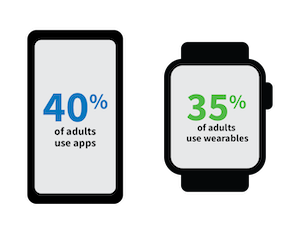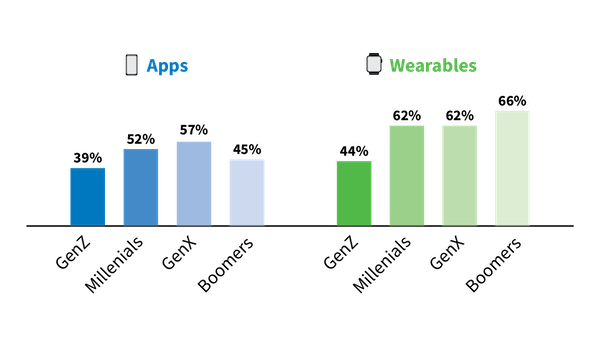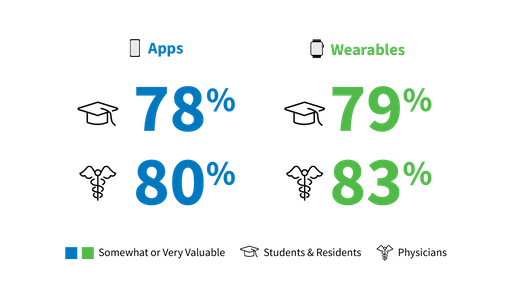A 2023 survey found that more than a third of U.S. adults—40%—use health apps to achieve fitness goals and track their health, an increase of 6% since 2018, while 35% use wearables, an increase of 8% since 2018.1 On the clinical side, roughly a third of physicians, residents, and medical students believe data from consumer health apps and wearables—aka, mHealth—can be very beneficial to patients but they also feel largely unprepared to use such tools in practice.2
Consumers are Buying into mHealth Apps & Wearables3,*
Frequency of App & Wearable Use — All Adults
Adults use apps more than wearables but use wearables more frequently.
 |
mHealth App Use: 40%
mHealth Wearable Use: 35%
|
Frequency of App & Wearable Use — By Gender3,*
Men and women use apps and wearables at roughly the same rate, though men use both slightly more frequently.
|
Overall App Use by Men: 40%
Overall Wearable Use by Men: 34%
|
Overall App Use by Women: 41%
Overall Wearable Use by Women: 35%
|
Frequency of App Use — By Generation3,*
Daily wearable use increased generationally with age while daily app use showed no age-related pattern. GenZ, however, reported daily use of both apps and wearables much lower than older generations.
 |
|
Overall App Use by Generation
|
Overall Wearable Use by Generation
|
The Confidence Gap in Clinical Use of Consumer mHealth2
Physicians have slightly higher confidence in the clinical value of wearable and app data than residents and medical students.
 Roughly half of physicians, medical students, and residents who perceived wearable data as very beneficial to patients felt very prepared to use it in their practice.
Roughly half of physicians, medical students, and residents who perceived wearable data as very beneficial to patients felt very prepared to use it in their practice.

Engaging Patients Who Use Consumer Apps & Wearables: Risk Reduction Strategies
While consumer mHealth apps and wearables can provide valuable insights for patients and physicians, they should always be considered as supplementary tools to support clinical decision-making. Regular patient engagement and open communication will help foster a collaborative approach and optimize the use of mHealth devices in patient care. When patients use these devices to track heart rates and other health parameters, consider the following risk reduction strategies:
- Educate Patients: Provide clear instructions and guidance to patients on the proper use of wearables. Ensure that they understand the limitations of the device and the importance of interpreting data in conjunction with clinical expertise.
- Emphasize Clinical Context: Remind patients that wearable data should be interpreted in the context of their overall health. Encourage them to report any symptoms or concerns, as wearables may not capture all relevant information.
- Set Realistic Expectations: Help patients understand the limitations of wearables. Explain that while these devices provide valuable insights, they may not replace professional medical evaluation. Encourage them to consult you for a comprehensive analysis.
- Establish Data Accuracy and Reliability: Advise patients to use medically validated wearables that have been tested for accuracy and reliability. Encourage them to share device specifications and performance reports with you for assessment.
- Validate Data: When patients present wearable data, cross-reference it with traditional clinical assessments. Compare the wearable’s data against standard medical measurements to ensure consistency and identify any discrepancies.
- Encourage Open Communication: Foster a collaborative relationship with patients by encouraging them to share their wearable data regularly. Establish channels for easy data sharing, such as secure messaging platforms or patient portals.
- Incorporate Wearables into the Workflow: Explore how wearable data can be integrated into your clinical workflow. Determine the best way to review and interpret the data, such as incorporating it into electronic health records or specialized software.
- Stay Updated with Technology: Stay informed about the latest wearable technologies, their capabilities, and limitations. Stay up-to-date with clinical guidelines and research related to wearable use in healthcare, including FDA approvals.
- Provide Ongoing Support: Offer guidance and support to patients when interpreting wearable data. Schedule regular follow-ups to review trends, patterns, and changes in the data, allowing for appropriate interventions when needed.
- Protect Patient Privacy and Data Security: Ensure that patient data transmitted from wearables is protected and stored securely. Adhere to data privacy regulations and implement robust security measures to safeguard patient information.
For physicians who do not endorse the use of wearables but encounter patients who are using them, it’s important to approach the situation with sensitivity and open communication. These risk reduction strategies can help in this scenario:
- Establish a Non-Judgmental Stance: Approach the topic with an open mind and refrain from being dismissive or judgmental about the patient’s use of wearables. Show respect for their choices and acknowledge their interest in monitoring their health.
- Explore Patient Motivations: Engage in a conversation to understand why the patient is using the wearable device. Ask open-ended questions to gather information about their goals, expectations, and concerns. This will help you better address their needs and provide appropriate guidance.
- Provide Evidence-Based Information: Share your professional expertise and provide evidence-based information about the limitations and potential risks of relying solely on wearables for health monitoring. Present scientific research or guidelines that support your viewpoint and explain how wearables fit into the broader context of medical care.
- Offer Alternative Monitoring Methods: Discuss alternative monitoring methods or tests that may provide more accurate and reliable data for assessing the patient’s condition. Highlight the value of in-person clinical assessments and the expertise of healthcare professionals in interpreting and managing health conditions.
- Document Discussions and Concerns: Make sure to document discussions about wearables in the patient’s medical record. Include any concerns expressed by the patient, your recommendations, and the rationale behind them. This documentation can help in continuity of care and serve as a reference for future interactions.
- Refer to Specialists if Needed: If a patient’s reliance on wearables becomes a significant concern or if they persistently dismiss medical advice based on the device’s data, consider referring them to a specialist or another healthcare professional who can provide a different perspective and further support.
- Educate on Limitations and Accuracy: Explain the limitations of wearable devices, including potential inaccuracies and variations in data quality. Help the patient understand that wearable data may not always provide a comprehensive picture of their health status or replace a thorough clinical evaluation.
- Encourage Shared Decision-Making: Collaborate with the patient in decision-making regarding their health. Help them understand the pros and cons of using wearables and explore potential compromises or middle ground that aligns with their goals while considering your professional recommendations.
- Foster a Supportive Relationship: Maintain a strong doctor-patient relationship built on trust and respect. Continuously reassure the patient that you have their best interests at heart and that your recommendations are based on their overall well-being.
- Stay Informed about Wearables: Keep up with the latest developments in wearable technology and related research. This will allow you to have informed discussions with patients, understand the evolving landscape, and provide up-to-date advice as the field progresses.
Remember, maintaining a patient-centered approach is crucial. While you may not endorse wearables, it’s important to respect patient autonomy and engage in productive conversations that prioritize their well-being and the delivery of quality healthcare.
Notes
* Frequency of use is for adults who indicated use of apps or wearables
References
1. Ricky Zipp. “The Public’s Use of Health Apps and Wearables Has Increased in Recent Years. But Digital Health Still Has Room to Grow.” Morning Consult. February 21, 2023.
2. Stanford Medicine. “Stanford Medicine 2020 Health Trends Report: The Rise of the Data-Driven Physician.” 2020.
3. Morning Consult. “National Tracking Poll #2301120.” January 23-25, 2023. Crosstabulation Results.
.png?width=2917&height=917&name=MicrosoftTeams-image%20(36).png)

